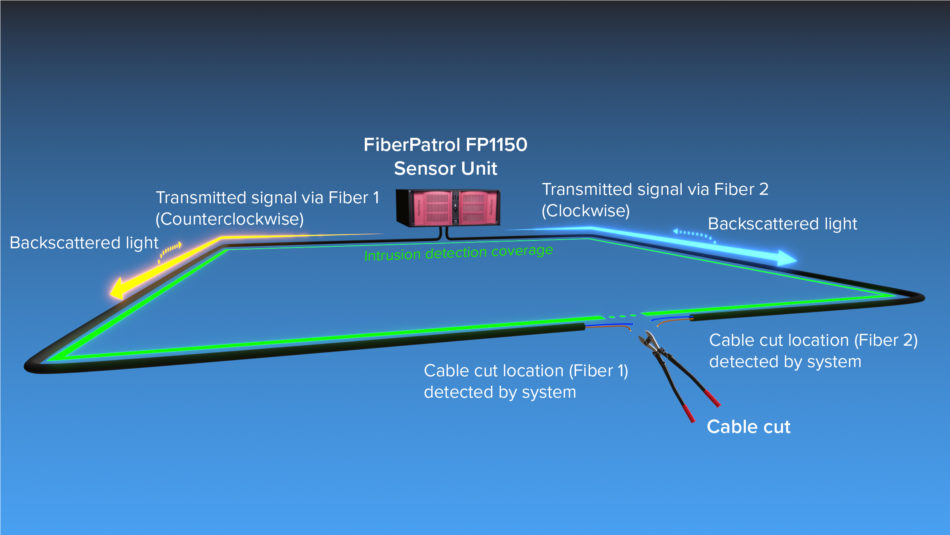Why a Fiber Security System Outperforms Traditional Security Systems
Why a Fiber Security System Outperforms Traditional Security Systems
Blog Article
The Ultimate Guide to Fiber Optic Security Systems for Your Company
In a period where protection problems are critical for services, understanding the intricacies of fiber optic technology can be transformative. This guide lays out just how integrating fiber optic protection systems not only enhances information defense yet also supplies benefits like resistance to interference and real-time surveillance capacities.
Recognizing Fiber Optic Modern Technology

The core of a fiber optic wire includes a thin glass or plastic center, bordered by a cladding layer that reflects light back into the core. fiber optic security system. This design makes sure marginal loss of signal strength, also over comprehensive distances. There are two key kinds of fiber optic cords: single-mode and multi-mode. Single-mode fibers are designed for long-distance transmission, while multi-mode fibers are ideal for much shorter distances, frequently used within buildings.
Optical fiber are not just quicker but additionally much more protected than traditional electrical wiring. Their inherent resistance to electro-magnetic interference and the trouble of taking advantage of the signal without discovery make them a recommended option for services prioritizing information honesty and protection. As organizations increasingly depend on safe and efficient communication systems, comprehending fiber optic innovation ends up being essential for notified decision-making.
Key Benefits of Fiber Optic Protection
When taking into consideration safety and security choices for a service, the benefits of fiber optic systems are especially compelling. Fiber optic modern technology offers remarkable data transmission rates and data transfer capacity, making it ideal for dealing with high-resolution video feeds from monitoring video cameras. This capacity makes sure that security employees obtain real-time information, improving overall feedback times to prospective security hazards.
In addition, fiber optic wires are naturally resistant to electro-magnetic interference, which can endanger the honesty of conventional copper-based systems. This resistance makes sure that the data transferred stays protected and undisturbed, supplying a much more reputable protection framework. Furthermore, optical fiber are much less at risk to physical damages, as they are made from glass instead of metal, minimizing upkeep expenses and downtime.
Fiber optic systems provide enhanced cybersecurity features, consisting of security capacities that protect sensitive information from unapproved accessibility. Collectively, these advantages make fiber optic safety and security systems a robust option for businesses seeking to improve their security steps.
Installment Process and Factors To Consider
Considering the intricacies entailed, the installment process of fiber optic safety systems requires cautious planning and implementation. The initial action entails a detailed website evaluation to determine ideal locations for cabling and tools. This evaluation must think about ecological variables, existing infrastructure, and potential susceptabilities.

In addition, the setup has to adhere to regional building regulations and industry standards. This might include coordinating with different stakeholders such as structure managers, IT teams, and security workers to guarantee seamless combination with existing systems.
Post-installation, rigorous screening is necessary to verify system performance and recognize any type of problems that might emerge. By prioritizing these considerations throughout the setup procedure, organizations can ensure a durable and reliable fiber optic safety system that fulfills their certain security demands.
Latest Innovations in Fiber Optic Protection
Recent advancements in fiber optic modern technology have substantially enhanced the abilities of protection systems for companies. One of one of the most noteworthy innovations is the combination of fiber optic sensing units that can find vibrations and breaches along the border of a center. These sensing units provide real-time monitoring, allowing rapid action to possible violations.
Furthermore, the advancement of distributed fiber optic noticing innovation permits the continuous monitoring pop over to this site of big locations with a solitary fiber wire. This technique not only minimizes installation expenses however additionally improves the integrity of keeping track of systems by removing the demand for several, different sensors.
Furthermore, advancements in multiplexing strategies have enabled companies to send large quantities of data over fiber optic networks, improving the abilities of video surveillance systems. High-definition video feeds can now be sent out over cross countries without loss of top quality, making certain that safety and security employees have access to clear and workable information.
Finally, making use of fabricated intelligence (AI) in conjunction with fiber optic systems is transforming hazard discovery. AI algorithms can assess information from fiber optic networks to identify unusual patterns or actions, allowing for proactive safety and security steps. These developments collectively represent a substantial leap ahead in fiber optic security innovation.
Choosing the Right System for Your Service
Selecting the appropriate fiber optic protection system for your service is vital for ensuring optimal protection and peace of mind. To make an informed choice, analyze your specific safety requirements, thinking about variables such as the dimension of your properties, the nature of your operations, and potential susceptabilities.
Begin by evaluating the level of safety and security called for; for example, high-risk environments may require advanced systems with integrated monitoring and breach detection capabilities. Next off, take into consideration scalability; as your business grows, your safety and security system should be capable of expanding to suit raised demands without considerable overhauls.
Additionally, examine the reliability and efficiency of numerous systems. Look for companies with well-known track records and customer reviews that vouch for their service top quality. It's likewise advisable to ask about the innovation's compatibility with existing facilities, reference ensuring a smooth assimilation procedure.
Verdict
In final thought, fiber optic security systems provide a durable solution for improving organization protection facilities. The most current resource innovations better bolster the performance of these systems, making sure that services stay safe and secure and versatile in an ever-evolving hazard landscape.
Report this page